Plant-Based Protein and Fat Substitutes for Common Ingredients
Updated: May 26, 2021
Registered dietitian Cynthia Sass shares plant-based alternatives and substitutes for the protein and fat that normally come from meat and dairy. Here's how to make healthy swaps for six common ingredients used in cooking and baking, like butter, eggs, and milk.
Our editors and experts handpick every product we feature. We may earn a commission from your purchases.
It’s safe to say the plant-based diet trend has become a solid movement, with no signs of slowing down. According to the Plant Based Foods Association, 29% of consumers categorize themselves as flexitarian, meaning they eat a wide variety of foods, but are actively trying to eat fewer animal products. And if you’re one of the many consumers trying to eat fewer animal foods, you may have lingering questions about exactly how to use plant alternatives. Some exchanges are pretty straightforward, like nut milk in your cereal instead of cow’s milk. But others may not be intuitive or may work well in some dishes, but not others.
To make your meal planning easier, here’s a handy guide to six substitutions, including how they work best, some information about the nutritional and environmental perks of making each swap, and what to look for when shopping.
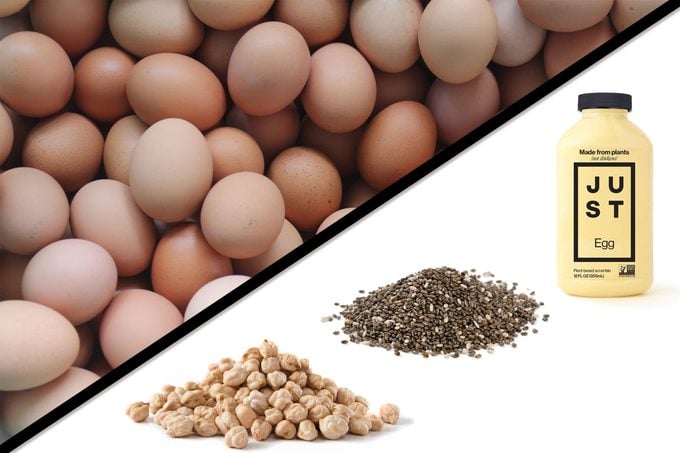
Egg alternatives and substitutes
One of the most convincing new plant-based foods on the market is Just. This liquid “plant egg” product, made primarily from mung bean protein, looks nearly identical to scrambled eggs when cooked. If you’re a fan of omelets or egg sandwiches, this is the closest plant-based egg replacement I’ve come across. One serving provides 5 grams of protein, 5 grams of fat, and 1 gram of carbohydrate. By comparison, one large whole egg contains 6 grams of protein, 5 grams of fat, and no carbs.
(Don’t miss these plant-based breakfast ideas nutritionists love.)
Use white beans or chickpeas as a whole food egg alternative
For a whole food alternative, try slightly mashed white beans or chickpeas. They work well in a scramble with veggies, extra virgin olive oil, garlic, and herbs. I have also used pureed beans in place of eggs to make mock quiche. While it may not have the same texture as cooked eggs, it’s a hearty one dish meal that can be made ahead, and enjoyed either hot or cold. Crumbled extra firm organic tofu also works well for eggless scrambles and eggless egg salad. If you can’t eat soy due to an allergy, you can now find a pumpkin seed tofu called Pumfu with a near-identical texture and high protein content.
Substitute chia seeds for eggs when baking
For baking and items like pancakes, my favorite egg substitute is chia seeds. Replace each whole egg with one tablespoon of the seeds combined with three tablespoons of water. The trade works for nearly any recipe, and chia seeds are major health boosters. They provide plant protein, fiber, and healthful fats, including anti-inflammatory plant-based omega-3 fatty acids. They’re also non-perishable, so you can keep your pantry stocked and use as needed.
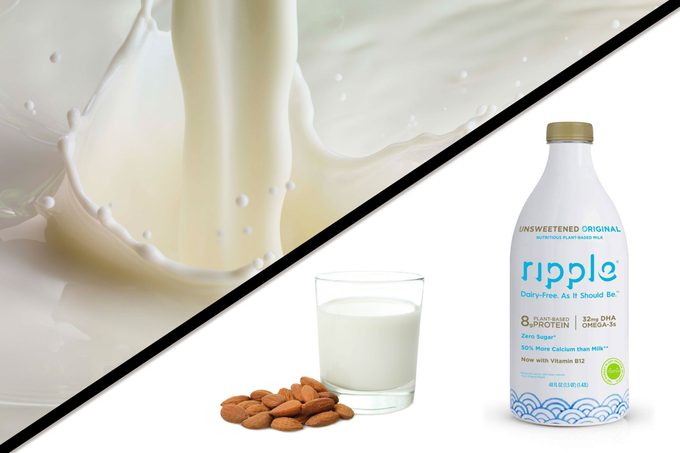
Non-dairy milk alternatives and substitutes
There is a wide variety of plant milk to choose from these days, including options made from grains, nuts, seeds, pulses, and more. If you have relied on cow’s milk as a regular source of protein and calcium, look for plant options with comparable levels of these important nutrients. For example, Ripple, made from peas, provides 8 grams of protein and 35% of the daily goal for calcium, slightly more of each nutrient than you’ll find in whole cow’s milk. Some plant milk provides just a single gram of protein per cup and little calcium, so becoming an avid label reader is key.
How to choose a plant milk
If you’re obtaining protein and calcium from different sources, there are other factors to consider when opting for plant milk in place of dairy. For example, some plant milk options provide a creamier, thicker texture, which may work best for dishes like soups, sauces, and casseroles. These include coconut milk, macadamia milk, and almond milk with a higher nut content. For example, Trader Joe’s Simply Almond Beverage packs four times more almonds than leading brands, which gives it a thicker, richer consistency.
If texture isn’t an issue—for example in smoothies—try mixing it up, as the nutrients and antioxidants found in oat milk differ from those in cashew, flax, and others. For the most versatility in both cooking and baking opt for unsweetened plant milk varieties. For more ideas, check out how to use cashew milk in everyday recipes.
Keep in mind that plant milk can vary considerably in their calorie, carb, sugar, fiber, and nutrient contents. And while some are made with just a few simple ingredients, others may contain preservatives, fillers, and other less desirable additives. Scan ingredient lists to preview exactly what’s in any carton before you add it to your grocery cart. (Here’s the difference between cashew milk vs. almond milk.)
Healthwise, cutting back on dairy may also be a smart way to protect your health. In a 2014 study, published in the British Medical Journal, researchers tracked over 100,000 Swedish residents for 20 years. They found that a high milk intake was associated with a greater incidence of fracture in women and a higher mortality risk during the study for some women and men.
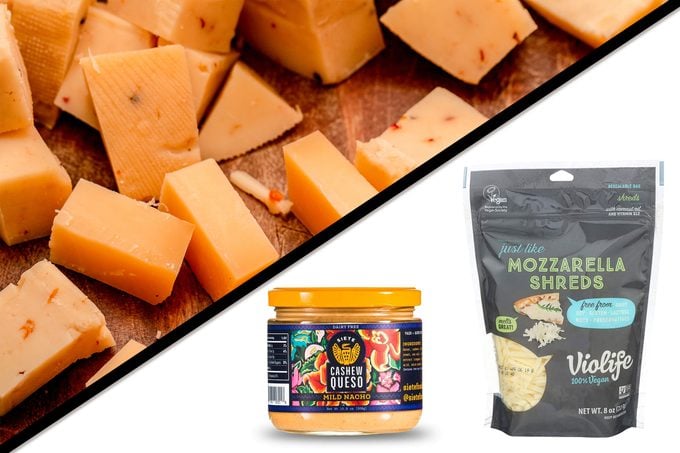
Cheese alternatives and substitutes
If you’re looking for the gooey stretch of melted cheese for pizza, try some of the shredded plant products that closely resemble the real deal. For example, VioLife, made primarily from coconut oil, potato, and corn starch, gets rave reviews for its cheesy mimicry. Another favorite sliced option is Follow Your Heart. My go-to for grilled cheese and sandwiches, this product has fooled several of my friends and family members with its authentic texture and flavor.
Homemade plant cheese
For parmesan, or to make homemade plant cheese, pick up some nutritional yeast. Also referred to as “nooch,” nutritional yeast has been a staple in plant-based cooking for decades. The characteristic golden flakes or powder are made from a type of yeast in the same family as baker’s and brewer’s yeast, but there’s no live yeast in the final product. It has a cheesy, nutty umami flavor that resembles cheese, with no animal-based ingredients. It can be sprinkled directly onto anything from popcorn to cooked veggies, pasta, and baked potatoes.
Cashew cheese
Nutritional yeast is also a key ingredient in cashew cheese, made from blending the nuts and yeast with plant milk, and seasonings like garlic, onion, turmeric, paprika, salt, and pepper. This do-it-yourself cheese can be used as a dip in place of queso, or in recipes like plant-based enchiladas. For a store-bought version, look for Siete Dairy Free Cashew Queso. In addition to its protein and B vitamins, a specific type of fiber found in nutritional yeast called beta-glucan has been shown to support immunity and bone density, reduce cholesterol and blood pressure, and potentially lower cancer risk, a 2017 study in the International Journal of Molecular Sciences suggests.
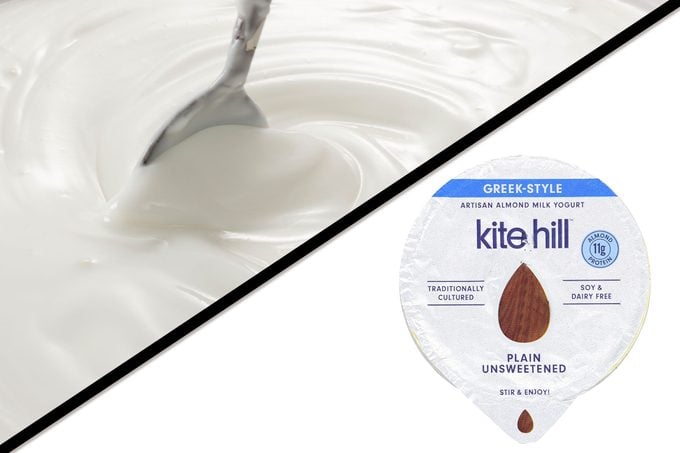
Yogurt alternatives and substitutes
Like milk and cheese, there are plenty of plant-based yogurt products to choose from these days. Options include those made from nuts, oats, coconut, soy, and more. If dairy-based Greek yogurt has been one of your staples for dishes like parfaits and dips, there is one clear plant-based standout to take its place. Kite Hill’s unsweetened Greek style almond milk yogurt provides the thick, richness of traditional Greek yogurt and packs 11 grams of protein per 5.3 ounce single serving container. It’s made simply from almond milk, tapioca starch, pectin, locust bean gum, and agar (the latter three are thickeners sourced from plants), and live active cultures. This plant option provides the same probiotic benefits of dairy-based yogurt, along with 4 grams of fiber, and 10 satisfying grams of heart-healthy fat.
Plant yogurts also vary considerably in their contents of protein, fat, fiber, vitamins, and minerals. If you’re simply looking for a yogurt texture without regard to protein or other specific nutrients, choose any you like. Just be sure to look for products with live active cultures to reap the benefits of probiotics, according to a 2017 study in Nutrients. These include enhanced immune function and gut health, anti-inflammation, positive mood, and better sleep, a 2019 study in Frontiers in Psychology suggests.
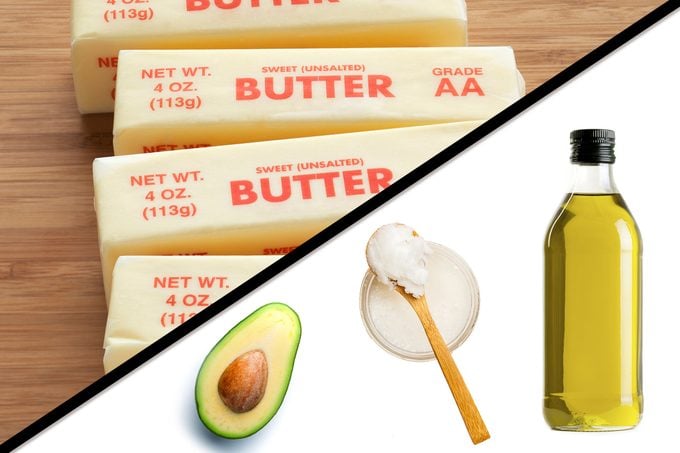
Butter alternatives and substitutes
Use extra virgin olive oil instead of butter
If you typically reach for butter to cook eggs, sauté vegetables, or make dishes like casseroles or soups, the best plant-based replacement is extra virgin olive oil (EVOO) in equal amounts. In addition to its heart-healthy monounsaturated fat, EVOO contains bioactive compounds with health-protective benefits, including antioxidants and anti-inflammatory substances linked to a reduced risk of obesity, type 2 diabetes, and cancer. You can use EVOO to make this high protein vegan stir fry recipe everyone will love.
Swap avocado for butter when baking
For baking, butter can be replaced with fruit often referred to as ‘nature’s butter’—avocado. Replace each tablespoon of butter for half a tablespoon of ripe avocado. This swap works well in cookies, brownies, cupcakes, muffins, and the like. The only caveat: the green pigment in avocado will come through. So this may work best in recipes that include cocoa powder to mask the color. Or, you can simply embrace the hue, and make greenies instead of blondies. In addition to their healthful monounsaturated fat, avocados are packed with a broad range of vitamins, minerals, fiber, and antioxidants.
Use virgin coconut oil for cooking and baking
Another butter substitute for both cooking and baking and is virgin coconut oil (VCO) in a 1:1 ratio. The firmness of VCO makes it a good option for cookies and bars. It also works well for high heat cooking, including stir fries or pan seared tofu. As far as its healthfulness, a 2017 study published BMJ Open compared the impact of coconut oil, butter, and olive oil, on heart disease risk factors in men and women. After consuming a little under two ounces of one of the fats daily for a month, scientists found different effects. Levels of “bad” LDL cholesterol increased in the butter group compared to those who consumed coconut and olive oils. Coconut oil also increased “good” HDL compared to the other fats. The researchers conclude that while coconut oil is predominantly saturated fat, as is butter, the unique chemical makeup of coconut oil, which differs from butter, may be protective. In other words, not all saturated fats are created equal.
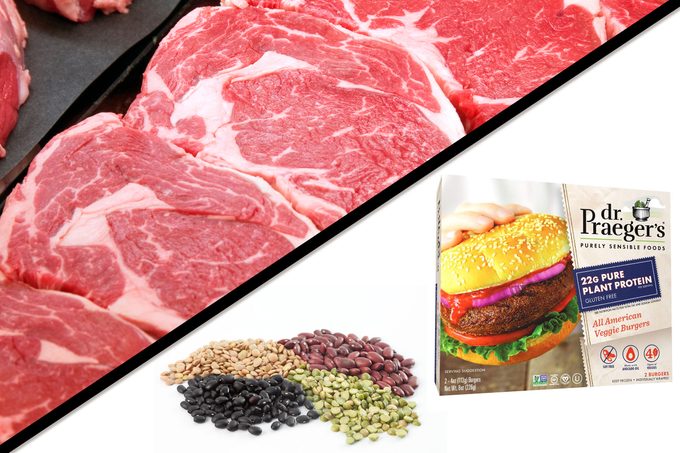
Meat alternatives and substitutes
Meat substitutions are plentiful, and the options continue to expand as new foods enter the market. These include veggie burgers, sausages, and crumbles, as well as faux poultry and pork made from pea protein, and products made from jackfruit and mushrooms. Don’t miss these jackfruit recipes everyone is bound to love.
These products vary significantly in their protein content, as well as how highly they are processed. When looking to replace meat, opt primarily for products made with easily recognized, whole food ingredients. And check out the grams of protein per serving. Some plant burgers can pack over 20 grams of protein, the amount similar to a three ounce chicken breast.
(On the go? Check out these plant-based fast food options.)
Use pulses as a whole food swap for meat
As for whole food options, my top recommendation is pulses, the umbrella term for the family of plants that include lentils, beans, peas, and chickpeas. One cup of cooked lentils provides 16 grams of protein, in addition to 15 grams of fiber (60% of the daily minimum target), antioxidants, B vitamins, and key minerals, including magnesium, potassium, zinc, and iron.
As a category, the consumption of pulses has been shown to support healthy weight management and fat loss, even without restricting calories, according to a 2016 study in The American Journal of Clinical Nutrition. This may be due to a combination of their fiber and their satiety-boosting benefits. You can use pulses directly in place of meat in dishes like tacos, salads, soups, and stir fries. Or transform them into meat-like meals, like lentil loaf, white bean meatless meatballs, and chilled chickenless chickpea salad.
Healthwise, a 2017 study in the Journal of the American Heart Association also demonstrates that exchanging animal protein for plant protein improves cholesterol profiles to reduce heart disease risk. The swap is also tied to reduced body weight and body fat percentage, according to a 2015 study in the Nutrition Journal.
Even if you don’t cut out meat completely, cutting back can have a positive impact on the health of the planet, as well as your personal health. For the greatest health and environmental benefit, combine meat alternatives with other whole plant-based foods, including generous portions of vegetables, whole grains, nuts, seeds, avocado, herbs, and spices.













